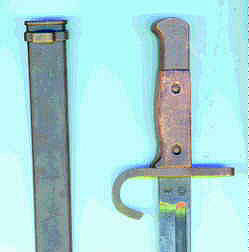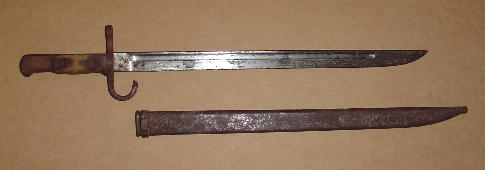Arisaka Bayonet
(aka Pattern 1897)



This is a knife/sword bayonet from the period of 1897 to about 1945.
Manufactured by various Japanese arsenals and sub-contractors and so marked on the blade ricasso; three examples are shown to the left:
Upper-left: manufactured prior to 1937 by Matsushita National under Tokyo Arsenal Supervision; markings - "stacked cannon balls" (one cannon ball stacked on three is the Koishikowa Arsenal mark) used by Tokyo and Kokura arsenals, followed by an "arrow through an M" for Matsushita National.
Middle-left: manufactured circa 1937-1945 by Kokura-Tokyo Arsenal, Kokura supervision (aka moji); "stacked cannon balls", one on three for Tokyo-Kokura and the "hourglass" mark of Kokura.
Lower-left: manufactured circa 1937-1945 by Toyoda Jodoshoki Seisakusho Arsenal (Toyoda Automatic Loom Works in Nagoya); two facing "dolphin-like sea creatures" (shachi) for Nagoya and a geometric design
that is a three-stacked-block figure within what is referred to as a "diamond" for Toyoda.
Overall length, in scabbard, is ~20-3/4";
Bayonet, out of scabbard, is ~20-1/4" in length;
Hilt is ~4-3/8" in length - not including forward-swept "blade-breaker" quillon.
Crossguard and pommel and made of steel; "blued" metal. Pommel has serial number stamped into butt; attaching mechanism (button) is on left side of pommel.
Two-piece grips are made of wood.
Straight single-edged blade is ~15-3/4" in length, ~7/8" wide at ricasso; "blued" blade; front half (tip half) sharpened;
fullered groove is ~12-1/4 in length beginning ~3/4" from crossguard and ending ~2-7/8" from tip. Ricasso is stamped with the maker's marks;
this example is stamped with the Tokyo Arsenal mark: "4 stacked cannon balls" (1 stacked on 3); and the contractor Matsushita National: "an arrow through an M".
Scabbard is ~16-1/4" in length; "blued" finish. Scabbard throat has a metal loop for attaching leather strap from belt attaching frog; drag has a rounded finial.
This bayonet was designed to fit the Type 30 (1897), Type 35 (1902), Type 38 (1905) and Type 99 (1939) Japanese Rifles and Carbines. Most of these bayonets are not rare, but all are becoming scarce in very-good condition.
They can be found in a number of variants, the most often seen without the hooked "blade-breaker" quillon or straight cross-guard. There are a number of crudely-made
variations called "last-ditch" and also a number of poorly manufactured "training" bayonets.
The scabbards can be found either steel or wood, depending on year of manufacture.
Please Note: These are currently being reproduced and offered by various distributors. Beware of these being offered as originals by secondary sources.




